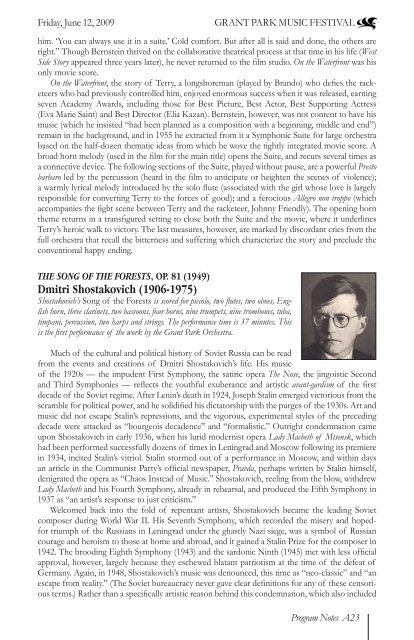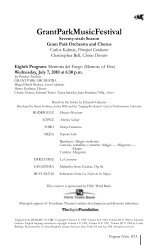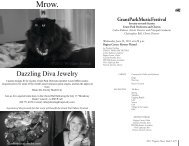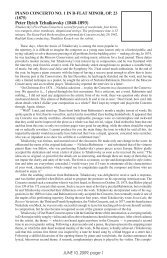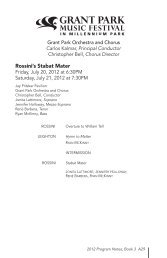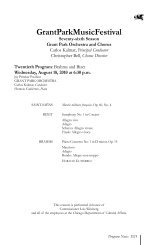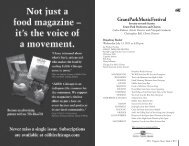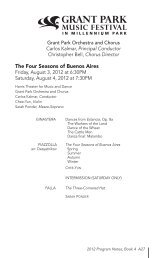Program Notes PDF - The Grant Park Music Festival
Program Notes PDF - The Grant Park Music Festival
Program Notes PDF - The Grant Park Music Festival
Create successful ePaper yourself
Turn your PDF publications into a flip-book with our unique Google optimized e-Paper software.
Friday, June 12, 2009<br />
GRANT PARK MUSIC FESTIVAL<br />
him. ‘You can always use it in a suite.’ Cold comfort. But after all is said and done, the others are<br />
right.” Though Bernstein thrived on the collaborative theatrical process at that time in his life (West<br />
Side Story appeared three years later), he never returned to the film studio. On the Waterfront was his<br />
only movie score.<br />
On the Waterfront, the story of Terry, a longshoreman (played by Brando) who defies the racketeers<br />
who had previously controlled him, enjoyed enormous success when it was released, earning<br />
seven Academy Awards, including those for Best Picture, Best Actor, Best Supporting Actress<br />
(Eva Marie Saint) and Best Director (Elia Kazan). Bernstein, however, was not content to have his<br />
music (which he insisted “had been planned as a composition with a beginning, middle and end”)<br />
remain in the background, and in 1955 he extracted from it a Symphonic Suite for large orchestra<br />
based on the half-dozen thematic ideas from which he wove the tightly integrated movie score. A<br />
broad horn melody (used in the film for the main title) opens the Suite, and recurs several times as<br />
a connective device. <strong>The</strong> following sections of the Suite, played without pause, are a powerful Presto<br />
barbaro led by the percussion (heard in the film to anticipate or heighten the scenes of violence);<br />
a warmly lyrical melody introduced by the solo flute (associated with the girl whose love is largely<br />
responsible for converting Terry to the forces of good); and a ferocious Allegro non troppo (which<br />
accompanies the fight scene between Terry and the racketeer, Johnny Friendly). <strong>The</strong> opening horn<br />
theme returns in a transfigured setting to close both the Suite and the movie, where it underlines<br />
Terry’s heroic walk to victory. <strong>The</strong> last measures, however, are marked by discordant cries from the<br />
full orchestra that recall the bitterness and suffering which characterize the story and preclude the<br />
conventional happy ending.<br />
<strong>The</strong> Song of the Forests, Op. 81 (1949)<br />
Dmitri Shostakovich (1906-1975)<br />
Shostakovich’s Song of the Forests is scored for piccolo, two flutes, two oboes, English<br />
horn, three clarinets, two bassoons, four horns, nine trumpets, nine trombones, tuba,<br />
timpani, percussion, two harps and strings. <strong>The</strong> performance time is 37 minutes. This<br />
is the first performance of the work by the <strong>Grant</strong> <strong>Park</strong> Orchestra.<br />
Much of the cultural and political history of Soviet Russia can be read<br />
from the events and creations of Dmitri Shostakovich’s life. His music<br />
of the 1920s — the impudent First Symphony, the satiric opera <strong>The</strong> Nose, the jingoistic Second<br />
and Third Symphonies — reflects the youthful exuberance and artistic avant-gardism of the first<br />
decade of the Soviet regime. After Lenin’s death in 1924, Joseph Stalin emerged victorious from the<br />
scramble for political power, and he solidified his dictatorship with the purges of the 1930s. Art and<br />
music did not escape Stalin’s repressions, and the vigorous, experimental styles of the preceding<br />
decade were attacked as “bourgeois decadence” and “formalistic.” Outright condemnation came<br />
upon Shostakovich in early 1936, when his lurid modernist opera Lady Macbeth of Mtsensk, which<br />
had been performed successfully dozens of times in Leningrad and Moscow following its premiere<br />
in 1934, incited Stalin’s vitriol. Stalin stormed out of a performance in Moscow, and within days<br />
an article in the Communist Party’s official newspaper, Pravda, perhaps written by Stalin himself,<br />
denigrated the opera as “Chaos Instead of <strong>Music</strong>.” Shostakovich, reeling from the blow, withdrew<br />
Lady Macbeth and his Fourth Symphony, already in rehearsal, and produced the Fifth Symphony in<br />
1937 as “an artist’s response to just criticism.”<br />
Welcomed back into the fold of repentant artists, Shostakovich became the leading Soviet<br />
composer during World War II. His Seventh Symphony, which recorded the misery and hopedfor<br />
triumph of the Russians in Leningrad under the ghastly Nazi siege, was a symbol of Russian<br />
courage and heroism to those at home and abroad, and it gained a Stalin Prize for the composer in<br />
1942. <strong>The</strong> brooding Eighth Symphony (1943) and the sardonic Ninth (1945) met with less official<br />
approval, however, largely because they eschewed blatant patriotism at the time of the defeat of<br />
Germany. Again, in 1948, Shostakovich’s music was denounced, this time as “neo-classic” and “an<br />
escape from reality.” (<strong>The</strong> Soviet bureaucracy never gave clear definitions for any of these censorious<br />
terms.) Rather than a specifically artistic reason behind this condemnation, which also included<br />
<strong>Program</strong> <strong>Notes</strong> A23


